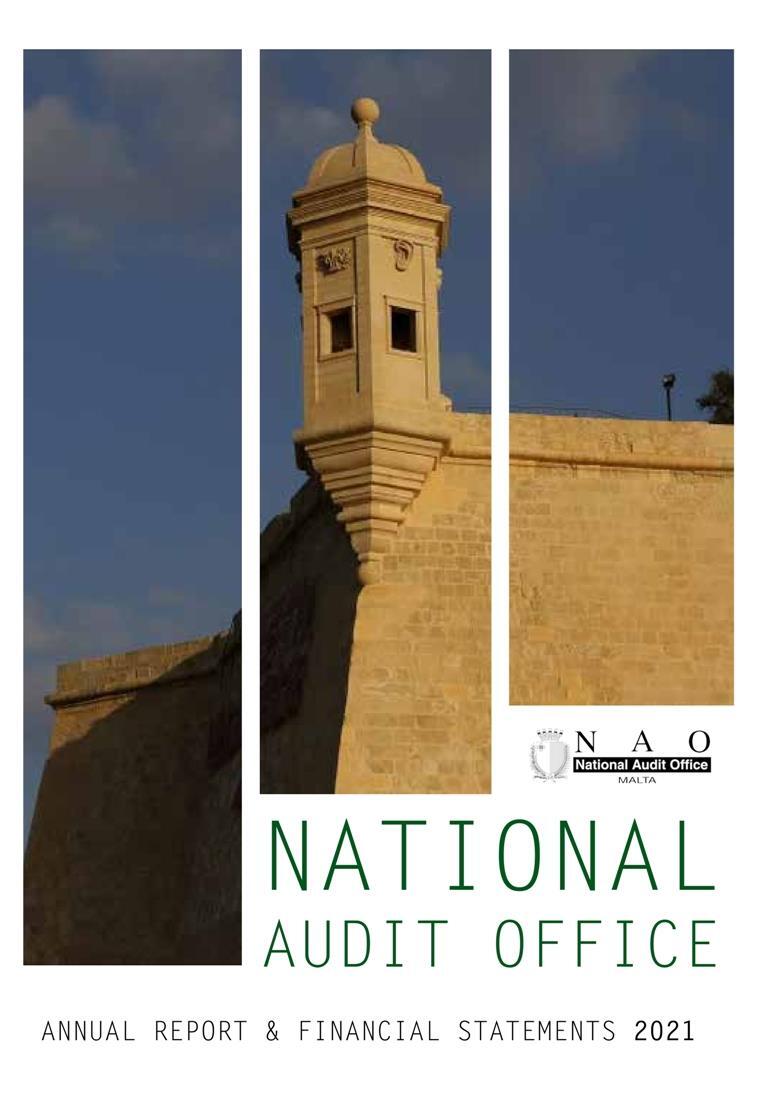- Home
- Publications
Publications
You may browse through our online list of NAO publications which include audit reports and annual reports. The audit reports are categorised according to the Classification of the Functions of Government (COFOG) developed by the OECD.
All Publications- Categories
- Publications Archive
- Events
- Careers
- About Us

Press Release
The Auditor General, Mr. Charles Deguara, presented the Report highlighted in caption to the Honourable Speaker of the House of Representatives Dr Anglu Farrugia.
In the foreword to the Report, the Auditor General provides an overview of the tasks, activities, developments, and achievements by NAO for 2021. In particular, he outlines a number of initiatives taken by the Office to gauge its performance and strengthen further its audit methodologies. He also referred to the various preparations being undertaken to celebrate in 2022 the 25th anniversary since the setting up of the National Audit Office as an independent Audit Institution by virtue of amendments to the Constitution through Section 108, and the enactment of the Auditor General and National Audit Office Act, 1997. To celebrate this milestone, the Office is planning the publication of a book on the Office that will be written to scholarly standards.
The Deputy Auditor General reflects on the NAO Strategy for the period 2019-2023 and delineates its various accomplishments. He makes particular mention of the NAO Performance Measurement Framework exercise, consisting of a self-assessment review of the various audit and administrative processes at the Office. He also puts forward a number of considerations that are to be taken into account when drafting the next strategy for the period 2024-2028.
The Report also includes an article by Dr Anglu Farrugia, Hon. Speaker of the House of Representatives, summarising those rulings of relevance to the National Audit Office.
Part One of the Report provides an overview of the external environment in which the NAO operated in 2021 and the key issues affecting the Office. These comprised: Public finances; Government and EU expenditure on Covid-19; infrastructural projects and investments (co-financed by the EU); developments and reforms within the Public Service; and the financial management reform. It also describes in some depth the results and output of the various audit and administrative Sections of the NAO as well as the NAO governance structure.
This part of the Report also makes reference to the participation of the NAO in a number of local and international activities. These include NAO active participation in meetings organised by the Contact Committee of Heads of EU Supreme Audit Institutions; European Organisation of Supreme Audit Institutions (EUROSAI) and the International Organisation of Supreme Audit Institutions (INTOSAI). Reference is also made to the annual seminar organised jointly by the NAO and the European Court of Auditors. The seminar was held on 2 November with the theme: `Addressing Key Emerging Issues through Public Audit.’
Part One ends with a report on Office relations with its internal and external stakeholders namely Parliament, auditees, educational institutions, the public, employees, participation of senior NAO officials in EU boards and participation in domestic working groups and committees. It presents the results of two surveys, one to auditees, and one to the general public, aimed to assess the overall performance of the Office.
Part Two of the Report comprises a description of the NAO business model. This model represents the processes that transform the various Office inputs to outputs and outcomes that create value over time across the various NAO capitals – financial capital, intellectual capital, manufactured capital, human capital, social and relationship capital, and environmental capital. This part also outlines the risks and opportunities present in the NAO’s environment that affect is ability to effectively carry out its mandate and thus create value over time.
It also provides an overview of the NAO Strategy and the work and outcomes of the six strategy action groups set up to implement it; as well as outlines their application to the Office’s audit and other processes. Part Two ends with the NAO Outlook for the future, in particular its plans to build on past successes and enhance the operations of the various NAO Audit and Administrative Sections.
The audited Financial Statements of the Office are presented in Part Three of the Report.To open NAO video follow link.
